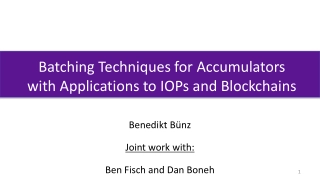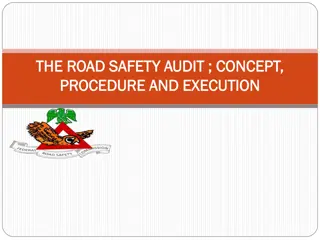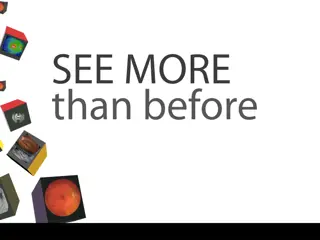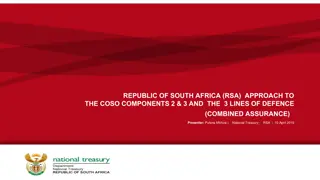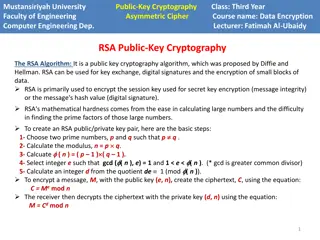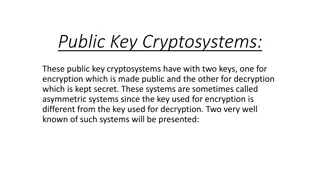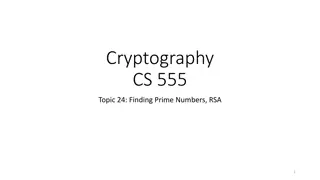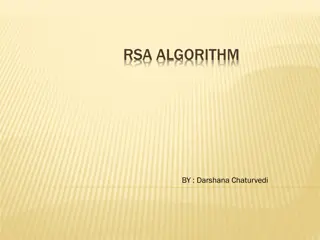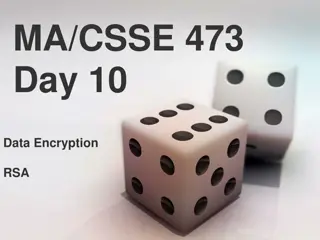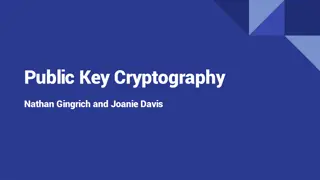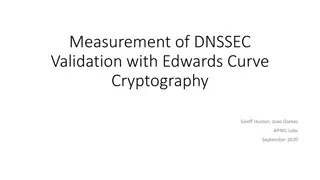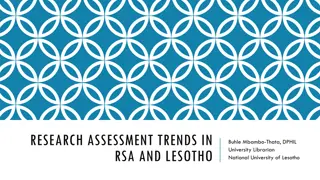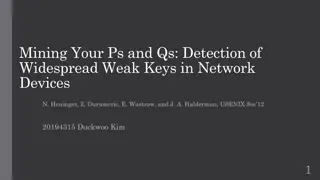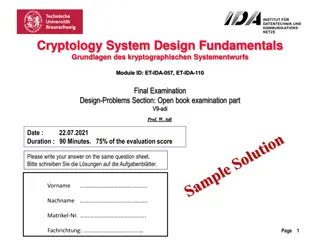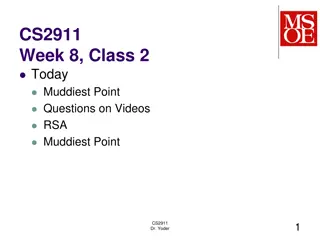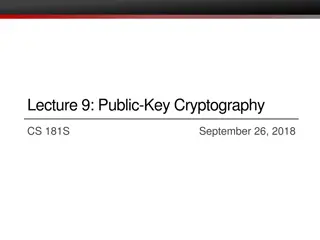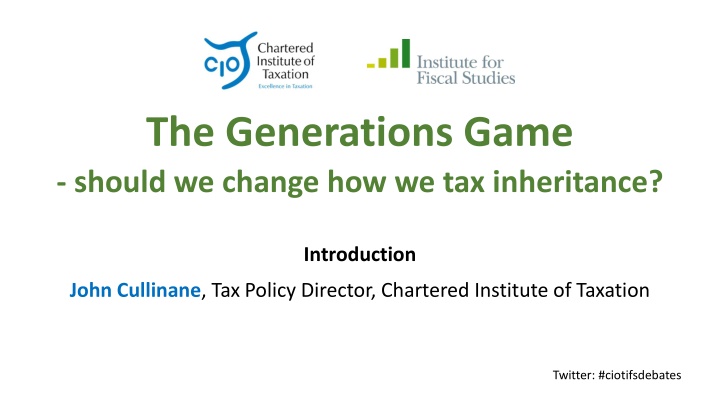
Reforming Inheritance Tax: A Historical Perspective and Policy Debate
Explore the evolution of inheritance tax from its origins in 1894 to current policies, including criticisms and changes made over the years. Delve into the debate on whether how we tax inheritances should be reformed, examining various viewpoints and proposals put forth by experts in the field.
Download Presentation

Please find below an Image/Link to download the presentation.
The content on the website is provided AS IS for your information and personal use only. It may not be sold, licensed, or shared on other websites without obtaining consent from the author. If you encounter any issues during the download, it is possible that the publisher has removed the file from their server.
You are allowed to download the files provided on this website for personal or commercial use, subject to the condition that they are used lawfully. All files are the property of their respective owners.
The content on the website is provided AS IS for your information and personal use only. It may not be sold, licensed, or shared on other websites without obtaining consent from the author.
E N D
Presentation Transcript
The Generations Game - should we change how we tax inheritance? Introduction John Cullinane, Tax Policy Director, Chartered Institute of Taxation Twitter: #ciotifsdebates
The Generations Game - should we change how we tax inheritance? In the Chair Paul Johnson, Director of the Institute for Fiscal Studies @PJTheEconomist Twitter: #ciotifsdebates
The generations game should we change how we tax inheritances? Emma Chamberlain Barrister Pump Court Tax Chambers October 2017
THE HISTORY Estate duty introduced in 1894 (at 1 to 8%), initially to tax a person s estate at death and then to catch gifts made in 7 years before death. Criticised as voluntary but no spouse exemption introduced until 1972 even then limited to 15,000. Top rate- 80% Capital transfer tax replaced estate duty in 1974. The aim, said Denis Healey, was to make the estate duty not a voluntary tax but a compulsory tax . By 1979 it had raised 38% less in real terms. CTT based upon the premise that all gifts of property whether made inter vivos or on death should be cumulated together and progressive rates of tax applied to ever increasing cumulative total Cradle to the grave tax . Passing property on death was merely the final gift. Loss to donor concept. Rates of 75% over 2m 5
THE HISTORY From 1979 the Conservatives made steady erosion into some basic principles of CTT. 10 year cumulation 1981. 1988 flat rate: 40% 1986 -PETS. Lifetime gift to individual is tax free if survives 7 years. Return to estate duty position so introduction of ROB provisions 1992 extension of 100% relief to business property and farmland 2006 fundamental changes to the taxation of trusts.20% tax Oct 2007 - introduction of transferable nil rate band; NRB= 325K April 2012 reduced rate of tax of 36% if 10% or more of death estate goes to charity 2017 introduction of residential nil rate band - 100-175K on death but not available on estates of +2.2m or if issue do not take house 6
Reliefs general policy is a flat high rate with lots of reliefs and exemptions favours the healthy, wealthy and well advised Spouse/civil partner exemption costs 4bn APR and BPR - costs just over 1bn and under review; business sold immediately after death can pass free of IHT and CGT. PETS - will you survive 7 years? Can you afford to make lifetime gifts? CGT - no CGT on death and assets in death estate rebased to MV Foreign doms no IHT on foreign situated property. Easy to achieve by inserting a foreign company above the UK assets. After [15 tax years] - deemed domiciled and taxed on worldwide estate but trusts set up before this by foreign doms are still generally protected from IHT. Excluded property trusts 7
Arbitrary? Regime for foreign doms is still very generous albeit cut down from 2017 in relation to residential property Do not sell your business before death and lose BPR and pay CGT. Has the donor married a younger spouse/civil partner to whom property can be left on revocable life interest with the life interest then ended shortly after donor s death property can then pass tax free to the next generation provided spouse/civil partner survives 7 years Do you have a decent Will or is it a mess? 8
What do other countries do? Rates, reliefs, scope of tax and its tail Pakistan, India, Sweden, Australia, China, Russia, Israel, New Zealand, Canada, Middle East countries no tax on death Italy 4% over 1m on transfers to spouse and issue; other - 8% Switzerland nothing at federal level but most cantons tax gifts to those other than spouse or issue albeit at very low rates France spouse exemption on death since 2007; E100k per child per parent rates of up to 45%. Some business reliefs; gifts within last 15 years taken into account. Use of usufructs Spain no spouse exemption; variable allowances between regions. Tax depends on relationship with the deceased; relief for main home; limited reliefs for family owned businesses 9
What do other countries do? Rates, reliefs, scope of tax and its tail Portugal - no IHT from 2004 but stamp duty at 10% unless estate passes to spouse or children Germany E500K exemption to spouses and E400K to each child; progressive rates between 7% and 50% depending on relationship with deceased; business reliefs but minimum period of ownership required by transferee so no immediate sale on death; allowances given every ten years; family home relief on death if not sold. Long tail if German resident citizen leaves Germany of up to 10 years USA - $5.45m NRB ($10.9 per couple); spouse exemption; no business reliefs; 40% maximum rate. Indefinite tail while still a US citizen 10
The options radical reform Wholesale reform with the introduction of a comprehensive donee based tax similar to Ireland. Rate of tax on transfers of wealth is governed not by the value of the donor s estate but by how much wealth the donee has inherited or been given during his lifetime from all sources. Argument is that it encourages more equal distribution of inherited wealth and wealth to be spread more widely. BUT significant administrative and compliance costs in a donee based Irish system Tax an inheritance as income of donee? 11
The options more limited reform More limited reforms e.g. 20% tax rate; higher NRB; longer run off on lifetime gifts say to 15 not 7 years; higher rates of tax on trusts Changes to BPR/APR so that: (a)transferee has to retain the business or farmland for a minimum length of time; e.g. five years (b)reduce 100% exemption to 50%; (c) correct anomalies about the relief. E.g. on investment assets held within the trading business (d)Cap it e.g. at 5m/10m BUT Powerful vested interests with legitimate concerns about a dry tax 12
The options- change to BPR and APR Administrative issues e.g. costs of valuation if relief not 100% or cap introduced A cap could penalise efficient businesses and lead to avoidance. e.g through fragmentation; trusts No CGT uplift on death in relation to business/farmland to the extent it qualifies for relief. CGT paid on later sale or lifetime gift Leads to less distortion - at present CGT is payable on a lifetime gift along with IHT if donor dies within 7 years compared with no CGT or IHT if the business is transferred on death 13
More radical options but within the existing system Return to CTT; abolition of spouse exemption; no CGT rebasing on anything along with IHT Should relationship of donee to the donor affect the rate of tax payable at death? Should some assets such as real estate be taxed differently? 14
Abolish IHT: CGT on death Abolition of IHT altogether too many vested interests. Raises relatively little revenue. Replace with CGT. CGT no longer forgiven on death and instead death is occasion of a deemed disposal that triggers CGT except on transfers between spouses when treated as no gain no loss transfer. Advantage is that all the machinery and reliefs to collect CGT are already present. People pay tax on an actual gain so more comprehensible and fairer. Does not tax transfers of wealth as such but the gain: this can be seen as unfair in that it does not redistribute wealth different rationale. Rates are currently lower 20% on gain not 40% on value 15
The options CGT on death Need to put a limit on main residence relief to stop people upsizing before death What about businesses? Death could be treated as a no gain no loss transfer on transfers of qualifying businesses and farmland so the gain is not taxed until an actual sale or voluntary lifetime gift- i.e. a rollover provision. Would it raise money transfers of cash would not be taxed at all on death but if a donor has cash he is likely to give it away anyway under the current regime. He may have paid CGT on an earlier sale Would need to impose CGT on lifetime gifts to trusts 16
The options CGT on death Emigration no tax at all after 6 years? Or sliding scale up to 10? Immigration rebasing on a foreigner becoming UK resident otherwise gains accruing when non-resident would be taxed. Would there be a 15 year rule as at present so only after 15 years would they pay CGT on foreign assets and this would include transfers on death? How are trusts taxed as they do not die and may hold assets indefinitely? What is the connecting factor: the trust, the beneficiary or the settlor? Impose a CGT charge every ten years on the trust credited against the tax due on final sale? Rather arbitrary 17
Conclusions Needs political consensus otherwise people just wait for a change of government Can we afford not to tax transfers of capital and wealth more efficiently however unpopular? Global consensus on how to tax transfers of wealth would help 18
Gift and inheritance tax Gift and inheritance tax in Ireland in Ireland Kieran Twomey Twomey Moran Private Client Tax Advisers
The Irish system The Irish system Ireland has an acquisitions tax Capital Acquisitions Tax ( CAT ) Introduced in 1976 but not copied from the UK CAT comprises a gift tax and an inheritance tax The recipient pays the tax not the estate Each recipient has a lifetime tax free amount The tax is a single rate of 33% Tax residence determines the charge not domicile (since 1999) 16 October 2017
The Irish system The Irish system continued continued Tax free thresholds are: EUR Relationship Class A 310,000 Child Class B 32,500 Brother/sister, nephew/niece, grandchild Class C 16,250 All other Transfers to a discretionary trust are taxed on appointment from the trust Discretionary trust tax 6% initial and 1% annual We have Business property relief (copied from the UK relief) (90%) Agricultural relief (90%) Dwelling house exemption (100%) 16 October 2017
2008 2008 - - 2017 2017 Two main changes In 2008, the tax rate was 20% In 2017, it is 33% (+65%) In 2008, the Class A tax free threshold was 521K In 2017, it is 310K 16 October 2017
Examples Examples 000 000 0 0 0000 000 Parents estate with 3 children 2,000 4,000 CAT @ 33% for each child 118 338 Total tax of family 354 1,014 Tax as % of estate 18% 25% UK IHT would be 540 1,340 Tax as a % of estate 27% 34% 16 October 2017
The key differences The key differences UK Ireland Basis of charge Domicile Residence Taxed on Estate Recipient Tax free 325k 310k (per child) Tax rate 40% 33% Gift tax None Full Discretionary trusts Advantages No advantage 16 October 2017
Planning Planning No magic solutions 16 October 2017
The stats The stats CAT yield is currently 431million 5 year projections are 450m 534m The 431m is split Inheritance tax 91/92% Gift tax CAT represents 0.88% of expected tax yield in 2017 8/9% 16 October 2017
The stats (contd) The stats (cont d) The number of taxpayers who paid CAT is 20,000 per annum 2016 19,898 cases 2015 22,451 cases 2014 19,441 cases In 2016, CAT was collected Group A 310,000 Group B 32,500 164m 195m Group C 16,250 73m 16 October 2017
How many pay CAT? How many pay CAT? Total Irish taxpayers in 2016 = 2.4 million Total who pay CAT = 20,000 cases = 0.8% of taxpayers 16 October 2017
Our policy? Our policy? 2009 Commission on Taxation Recommendation Reduce business/agricultural relief to 75% (from 90%) Monetary cap of 3m on business/agricultural relief Programme for Government We will increase the Class threshold to 500K 16 October 2017
The Irish Public Mood The Irish Public Mood No public outcry No lobbying Not on the agenda? 16 October 2017
Thank you. 16 October 2017
The Generations Game - should we change how we tax inheritance? Panel Discussion and Q & A Panellists: Emma Chamberlain OBE, Barrister at Pump Court Tax Chambers Kieran Twomey, Founding Director, Twomey Moran, and Council Member, Irish Tax Institute Chair: Paul Johnson, Director of the Institute for Fiscal Studies Twitter: #ciotifsdebates
The Generations Game - should we change how we tax inheritance? Close Please join us for drinks and nibbles in the Benjamin Franklin room Twitter: #ciotifsdebates


